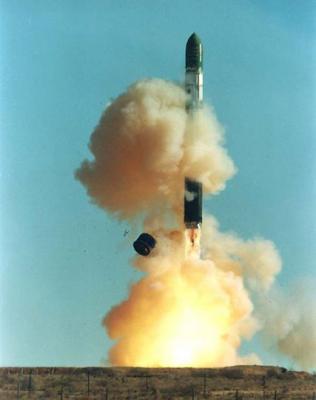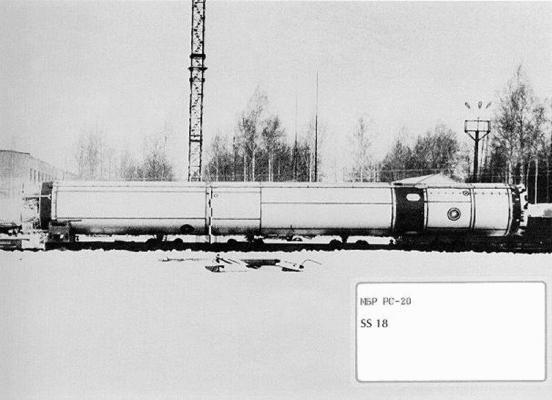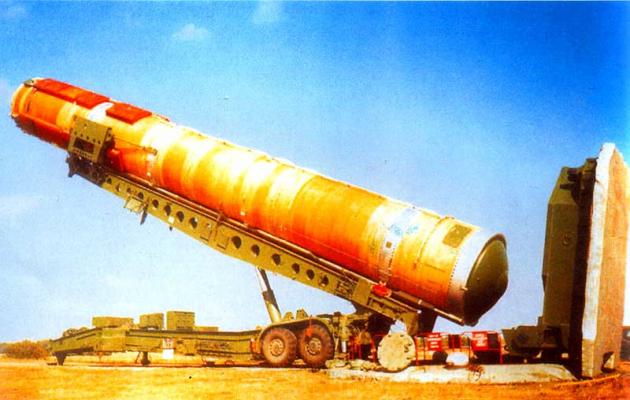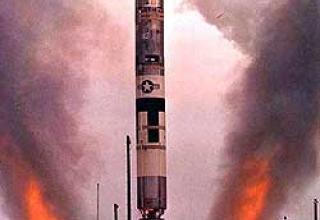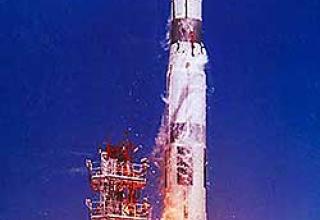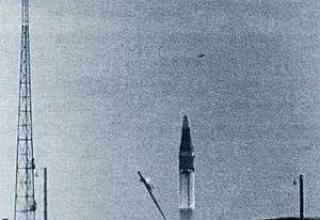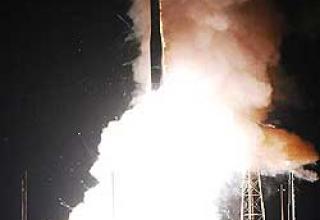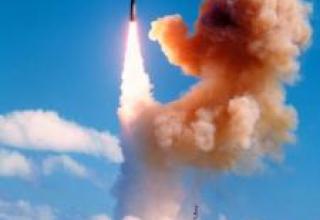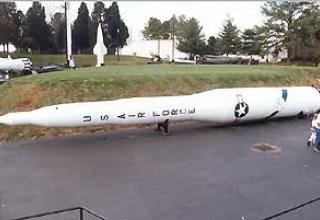The third-generation 15P018 strategic missile system (R-36M UTTH) with the 15A18 missile equipped with a 10-block split head unit (RSH) was created as a result of the implementation of the program to improve and enhance the combat efficiency of the previously developed RK 15P014 (R-36M) and is a highly effective, universal complex of strategic purpose. The complex provides destruction of up to 10 targets by one missile, including high-strength small and especially large targets located on the terrain with the area of up to 300000 sq.km, under conditions of effective counteraction of the probable enemy's missile defense means.
The development of the 15P018 complex was set by the Decree of the Central Committee and the USSR CM of August 16, 1976.
Flight tests of R-36M UTTH began on October 31, 1977 at Baikonur test site and ended on November 27, 1979. September 18, 1979 three missile regiments (Zhangiztobe, Dombarovsky, Uzhur, commanders: G.M.Kanevsky, V.I.Zverev, G.S.Sidorenko) began to carry out combat duty on new missile equipment.
In the second half of 1970s the KBSM carried out work to improve the security of missile systems 15P018. As a result, a complex was created that is as secure as American strategic ground-based missiles.
As of 1987, 308 R-36M UTTH ICBMs (Dombarovsky, Kartaly, Zhangiz-Tobe, Aleisk, Uzhur and Derzhavinsk) were deployed in five missile divisions, each with 30, 46, 52 or 64 SHDs. As of 1998, 122 silo launchers (SLBMs) with UTTKh's R-36M ICBMs remained in the Strategic Missile Forces.
The serial production of R-36M UTTH missiles was organized at Yuzhny Machine-Building Plant in Dnepropetrovsk.
The efficiency of RK 15P018 as compared to the prototype was improved:
- to increase firing accuracy by a factor of two to three;
- increasing the charge power of combat units (BBs);
- increase in the area of BC breeding;
- application of high security control gear and controls;
- increasing the probability of bringing commands to the launch to the automatic programmable control gear.
In 1983, the design team of Yuzhnoye Design Office was tasked with refining the R-36M UTTH missile so that it could overcome the promising U.S. missile defense system, as well as improve the protection of the missile and the entire complex to the effects of nuclear explosion. The flight development tests of the new fourth generation intercontinental missile, which replaced the R-36M UTTH and was designated R-36M2 (15A18M - "Voevoda"), were completed in September 1989.
In the west, the R-36M UTTH complex was designated SS-18 "Satan" mod.4 ("Satan"), under the START-1 contract - RS-20B.
Composition:
In general, the layout of 15A18 missile is similar to 15A14 and includes first, second and combat stages. As part of the 15A18 missile used without modifications I and II stage 15A14. Injection of fuel tanks - chemical: fuel tanks - oxidizer injection, oxidizer tanks - fuel injection. Material of the body of fuel tanks - aluminum-magnesium alloy. First stage engine - four-chamber ZHRD RD-264 of closed type with fuel consumption control system. The second stage is equipped with single-chamber marching and four-chamber steering rocket engines (ZHRD RD-0229 and RD-0257), made according to the closed and open design scheme respectively. Separation of stages, separation of combat stage - gas-dynamic.
For the 15A18 missile, a new stage 15B157 with a diameter of 3m and a height of 1m was developed, equipped with LRD with oscillating chambers operating on the main fuel components, and a new 15F183 RSH with ten new 15F162 high-speed blocks, equipped with A134GA charges. The 15D177 engine for the stage of dilution was designed as a four-chamber, open circuit, without afterburning the generator gas, two-mode (thrust 2000 kgf and 800 kgf) with multiple (up to 25 times) switching from one mode to another to create the most optimal conditions for the dilution of all the units in the likely theaters of war.
One of the engine design features is two fixed positions of combustion chambers. During transportation and flight, the KC missiles were located inside the dilution stage. After separation of the stage from the rocket, special mechanisms led the chambers to the outer circuit of the compartment, unfolded them into the working position to implement a "pulling" scheme of separation of the ballistic missile and fixed with pneumatic clamps. On this engine, for the first time, a check was introduced to ensure that the lines were not blocked by blowing with air and measuring pressure drops by rotameters.
The new 15F183 RSH was made according to the two-level scheme with a single aerodynamic fairing. For the first time there were developed and applied impulse-free devices for separation of booster units and spring tappets that swirl booster units around the axis at the moment of their separation from the platform.
Modernization of the control system consisted in implementation of more complete control laws with reduction of methodical errors to almost zero, as well as increase of the BCVM memory. At the same time, firing accuracy was improved by 2.5 times, and the missile launch readiness time was reduced to 62s.
Aiming system with improved parameters, which was achieved by increasing the accuracy characteristics of the equipment, increasing the shock resistance and impact resistance, including automatic gyrocompass in the unfolded position, the use of a system of preemptive launch and a quantum optical gyrometer with high speed, which allows for multiple correction of sighting at given models of nuclear effect on the NC.
The combat launch complex (see diagram) for the R-36M UTTX ICBM was developed at the Special Machine-Building Design Bureau (SDO) under the supervision of Chief Designer V.S. Stepanov; it includes 6 mine launchers of the OS type (single launch) of high protection and one unified command post of the KP 15B155 (15B52U) high protection of container type. The KP 15B52U was developed at the Central Design Bureau of Materials under the supervision of B.R.Aksyutin and A.A.Leontenkov. The control unit is placed on a suspension in the mine on special depreciation. The weight of the control unit is 130 tons. The diameter of the control panel is 5.9m, height - 39m. A large degree of borrowing units and systems from the complex 15P014 and their development by industrial enterprises ensured high manufacturability of systems and equipment of the created complex and the possibility of its production with minimum costs in a short time. Operational characteristics of the whole complex have been significantly improved, as well as protection of mine start-up units and control points has been increased.
The R-36M UTTH rocket in a transport and launch container (see photo) is installed in a silo launcher and is on full alert in a fueled state. Thermostatically controlled TPKH. Length 27.9, diameter 3.5m. Type of launch - mortar, with a special pallet on which the PAD is mounted, after leaving the slide, the pallet is separated by a spring pusher and driven towards the powder rocket motor. The system of depreciation of TPK in the slurry zone is of pendulum type, horizontal - double belt with hydrodampers, vertical - with a pneumatic shock absorber. Production of pneumatic shock absorbers was deployed at the Volgograd Barrikady plant.
To load the P-36M ICBM and 15B52U command post into the mine structure, the MAZ SKB developed special transport and installation equipment in the form of high cross-country ability semi-trailer (see photo) with MAZ-537 tractor. The main components and systems of the installer include: frame, boom, boom lifting and lowering mechanism, rear wheel drive, rescue system, hydraulic system, electrical equipment, auxiliary equipment. The weight of the road train is 69914 kg, front axle load is 42000 kg, rear axle load is 27914 kg, turning radius is 35m. Length - 26460 mm, height - 4600 mm, width - 3350 mm.
The combat application of the complex is provided in any weather conditions at air temperature from -50 to +50 ° C and wind speed at the ground surface up to 25 m/s, including after the nuclear impact on the DBK.
Characteristics:
| General characteristics | |
| Maximum firing range, km | 11000 |
| Firing accuracy (range 10000 km), km | ±0.65 |
| Generalized reliability | 0.93 |
| Launch time from full alert, s. | 62 |
| Rocket's resistance to harmful factors of Java in flight | level 1 |
| Warranty period on combat duty, years | >10 |
| 15A18 missile | |
| Launching weight of the rocket, tc | 211.1 |
| Weight of the head end, kgs | 8470 |
| Weight of fuel, shh: - Stairs I - II stages - stages of breeding |
150.5 37.6 2.1 |
| Flight Reliability | 0.965 |
| Energy Performance Coefficient Spg/Go, kgf/t | 40.1 |
| Diameter, m | 3 |
| Length, m | 34.3 |
| Remote Control Features | |
| Tractor remote control (on the ground / in the void), ps: - Stairs I - II stages - stages of breeding |
424.8/461.2 - / 77.5 - / 2.0 |
| Remote control specific impulse (on/in the ground/in the void), c: - Stage I - II stages - stages of breeding |
293.3/318.4 - / 325.5 - / 290.4 |
Testing:
According to the flight test program, 19 launches were conducted at 5 NIIP, 17 of which were successful. The reasons for two failures were the loss of stability of the first stage due to the failure of the steering machine, the loss of stability of the combat stage due to the abnormal separation of it from the second stage (the presence of mechanical communication after the separation command). The causes were eliminated and the effectiveness of the measures taken was confirmed by subsequent launches. There were 62 launches in total, of which 56 were successful. The actual flight reliability of the missile, taking into account modifications at the flight test stage and quality assurance of manufacturing, is 0.965.
High reliability of the complex is confirmed by 159 successful launches as of September 2000, of which only four were unsuccessful. Four failures at serial launches are caused by manufacturing defects.
The collapse of the USSR and difficulties in the economic development of Russia in the 1990s required the extension of the service life of the R-36M UTTKh ICBMs until they were replaced by Russian designed complexes. To this end, on April 17, 1997, the R-36M UTTH missile manufactured 19.5 years ago was successfully launched. Yuzhnoye, together with the 4th Central Research Institute of the Ministry of Defense, carried out work to increase the guaranteed service life of the missiles from 10 years to 15, 18 and 20 years in succession. On April 15, 1998, the R-36M UTTH rocket was launched from Baikonur Cosmodrome, where ten training combat units hit all training targets at the Kura test site in Kamchatka.
Specialists from Russia and Ukraine proposed to create on the basis of R-36M UTTH/ R-36M2 missiles a space rocket system for launching into circular 300-kilometre near-Earth and highly elliptical orbits spacecraft weighing more than 3 tonnes. To implement this programme, named Dnepr, a special Russian-Ukrainian international space company, Kosmotras, was established in 1997 by the Governments of the Russian Federation and Ukraine. It brought together the parent enterprises of the two countries that had once built the R-36M ICBMs.
On 21 April 1999, the English scientific satellite Uosat-12 was launched from the Baikonur Cosmodrome using the Dnepr LV. On 26 September 2000, five small scientific satellites from Italy, Saudi Arabia and Malaysia were put into orbit.
Sources:
- "Призваны временем. Ракеты и космические аппараты конструкторского бюро "Южное"./ Под общей редакцией С.Н.Конюхова/. Д.: Арт-Пресс, 2004,-232с.
- "КБ специального машиностроения: От артиллерийских систем до стартовых комплексов" (под редакцией Ушакова В.С.) .СПб, 2004.
- Карпенко А.В., Уткин А.Ф., Попов А.Д. "Отечественные стратегические ракетные комплексы". СПб, Невский бастион-Гангут 1999 год.
- Колесников С. Г. "Стратегическое ракетно-ядерное оружие". Арсенал-Пресс 1996 год.
- Межконтинентальная баллистическая ракета Р-36М (15А14) / Р-36МУ (15А18) / Р-36М2 (15А18У)
- С. Деревяшкин,А.Богатырев, "Сатана" - дочь "Воеводы" «Красная звезда». 21.04.2001
- Ракета носитель "Днепр" ICS "Космотранс"
- "Cатана" превращается в "Днепр" Space News.ru
